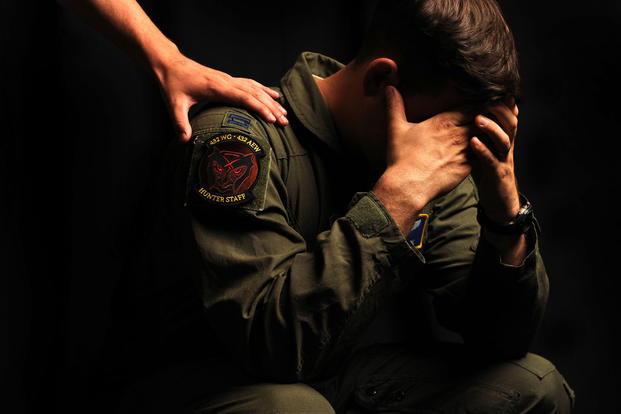Kacie Kelly is Deputy Director of the Military Service Initiative at the George W. Bush Institute, where she oversees and manages policy, operational, and programmatic efforts on veteran health and well-being, including the Warrior Wellness Alliance.
Recent media reports surrounding a study on military PTSD treatment highlight some important ongoing challenges -- but they don’t tell the whole story. And because of that, people could be getting the wrong message about effective care.
In a Jan. 30 study published by the Journal of the American Medical Association, the authors assessed findings from many years of research on PTSD treatment outcomes. While the study rightly notes that trauma-focused therapies are good at treating PTSD, the authors made some conclusions that suggest trauma-focused therapies should not be prioritized as a first-line treatment. The headlines, jumping on this, unfortunately fail to paint a complete picture of the current state of care for veterans and servicemembers with trauma-related injuries, and may inadvertently reinforce negative perceptions about seeking mental healthcare.
Mental health, like physical health, often has a range of valid treatment options. Leading scientists in the field regularly review existing research to determine what should be the best choice for any given condition and provide guidance for practicing clinicians. Treatment options for PTSD might include various types of talk therapy, medication, or some combination, but research has consistently demonstrated that trauma-focused treatments are the best first choice for treatment.
Specifically, Cognitive Processing Therapy (CPT) and Prolonged Exposure Therapy (PE) are good options and do work for many veterans. Some 30-50% of veterans who participate in one of these treatments experience significant symptom reduction and no longer meet criteria for PTSD diagnosis following treatment. While a recent publication called into question the effectiveness of CPT and PE with all veterans, another recent review of the literature on treatments of veterans and servicemembers with PTSD (supported by the International Society of Traumatic Stress Studies) concluded that these treatments should be used as first-line treatments while acknowledging the limitations (such as dropout rates and treatment complexities with often co-occurring conditions).
It seems the solution should be advocacy for research into new treatments for individuals who do not benefit from the first-line treatments. The study’s coverage unfortunately took a different and concerning approach, inaccurately suggesting that the treatments do not work.
For comparison, consider cancer treatment. There are multiple courses of treatment for an individual experiencing colorectal cancer. The first-line treatment for this disease is a partial or complete surgical removal, and according to the American Cancer Association, the 10-year survival rate is 59 percent. Would we suggest that someone with colorectal cancer not have surgery for this cancer, knowing that the treatment only works for some? Of course not. While we encourage innovation in healthcare, we must also value context and nuance in data, so people are not discouraged from reaching out for help that works.
There should be more precision in diagnosing, understanding, and treating veterans and service members with PTSD, but there must also be more accuracy in describing the existing evidence on diagnostic and treatment advances that have been made. We should also take into consideration the fact that, like most health care, that there is no one-size-fits-all approach when it comes to treating each individual.
Andrew Coughlin, a retired U.S. Army Specialist and an avid mountain biker who’s a member of the George W. Bush Institute’s Team 43, struggled for many years during his transition from active-duty service. He connected to high-quality care at the Marcus Institute for Brain Health to address his PTSD and challenges associated with traumatic brain injury (TBI). At MIBH, Andrew participated in a 4-week comprehensive and integrated program that included Eye Movement Desensitization & Reprocessing (EMDR) and other trauma-focused treatments.
Andrew today tells others “help is available, and people want to help.” Based on his life-changing experiences in the program, he encourages other veterans “not to give up and to take some responsibility for treatment.”
He’s right. Veterans need to be engaged in treatment decisions, recognizing that mental wellbeing isn’t transactional, and PTSD is usually not binary or isolated. And they should also become educated on what effective treatments are available to them, including innovative solutions. The Wounded Warrior Project’s Warrior Care Network, for instance, provides 70 hours of therapy during a 2-3 week program, demonstrates exciting results with more symptom reduction, overall improvement in outcomes, and a completion rate of over 90%. Treatments such as CPT, PE, and EMDR are effective treatments for many with traumatic military experiences, and veterans should know about and ask for them.
Innovation, education, and partnerships are key in this effort. That’s why the Bush Institute’s Warrior Wellness Alliance has united 15 organizations around a single mission to connect more veterans to high quality care when they need it. By linking veteran peer networks to high quality clinical programs for the invisible wounds of war, our hope is that together we will help more veterans reach out for help and navigate to high-quality care for PTSD that exists across the country.
Continued research and innovation to improve treatment options are certainly important, so veterans can access the right care at the right time, and at the right place. While we have much work to do, the invisible wounds of war are real injuries that can be treated successfully. It’s our duty to get it right for those who have sacrificed much for our country. By helping more men and women in uniform seek and access quality care for the invisible wounds, we’ll enable each of them to continue to lead and serve our country even after they have taken off the uniform.
-- The opinions expressed in this op-ed are those of the author and do not necessarily reflect the views of Military.com. If you would like to submit your own commentary, please send your article to opinions@military.com for consideration.















